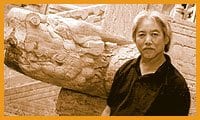For Wayson Choy life is not some random collection of events. He believes in signs, particularly that everything in life comes full circle. Even seemingly unimportant events and acquaintances will some how, some day, turn out to be life changing.
“Everything significant in my life was visible in the beginning, even if I didn’t see it at the time. Everything comes back around,” he says. As evidence he cites the fact that his goddaughter Tosh visited him in Toronto from her home in the US in the summer of 2001 when Choy was hospitalized following a near-fatal asthma-induced coma and a series of heart attacks. A cardiac nurse was needed to assist in an operation and for post-operative care. It just so happened that Tosh is a cardiac nurse and it was she, whom Choy once helped to raise, who brought him back to health.
“There are so many circles. And the older I get, the more I see. That’s the miracle of living long enough to see life loop around. My books have brought people back to me that I’d never thought I’d see again. All that history you forget. And sometimes,” he says, laughing, “history you don’t want to remember.”
The weight of family history – and family secrets – is a central theme of Choy’s writing. His first novel from 1995 The Jade Peony, his 1999 memoir Paper Shadows and his second novel All That Matters, a follow-up to The Jade Peony, published this month, are set in Vancouver’s Chinatown in the 1940s, where Choy, who was born in 1939, grew up. As he vividly recalls the neighbourhood in his books, it was mix of rich colours and the dueling smells of old world cooking and freight trains, where the promise and hope of a better life clashed with the realities of anti-Chinese racism, the head tax and the Exclusion Act.
The Jade Peony and All That Matters tell the story of the Chens, an immigrant family headed up by kind, industrious Father and formidable Poh-Poh (grandmother) who are sponsored by Third Uncle, a distant relative and prosperous Chinatown businessman who brings them to Vancouver with forged paperwork. The Chens struggle to leave behind the violence and poverty of Old China while honouring tradition through elaborate courtesies, Chinese lessons, Mah Jong games and the dutiful display of a picture of the Kitchen God.
While The Jade Peony is told through the perspective of the three youngest children, All That Matters is narrated by First Son Kiam-Kim. Thoughtful, bright and sensitive, it is up to Chinese-born Kiam-Kim to bridge the family’s two cultures, to watch out for his siblings and to follow Poh-Poh’s directive that he never lose his “Chinese brain.” In Choy’s skillful, elegant hands, the retelling of the Chens’ fortunes and failings is as moving as ever. The Chen family is caught up in swirl of world history – immigration, the Great Depression, World War II – but also in the small everydayness of their lives – bargaining with the grocers, falling in love, getting along with the Irish neighbours. It’s not a new story, but Choy tells it with freshness, humour and deep compassion.
“I had started the novel before the coma and I was just playing. After the illness, everything deepened for me. What I came to understand about life is that common acts of decency are often the most meaningful ones. When I was in the hospital, I had friend who brought me icy water every day because I craved the coldness of it. Every day! It meant everything to me.
“I had the image of a butterfly in my head while I was writing the book. I loved the idea that a butterfly flapping its wings could cause a tornado a thousand miles away. I loved the idea of a small act having a huge, unexpected impact.”
Much of the detail and texture of the setting is drawn from Choy’s own family story. His grandmother, who he recalls had the bound feet of Chinese tradition, was domineering and difficult and eventually a feud splintered the family. Choy’s own parents kept Wayson’s adoption a secret – a fact he only learned by chance in his 50s.
Still, Choy didn’t realize what a goldmine of material he had until he was in his late 30s. “I had internalized the idea that my family’s story didn’t count. I was a banana. Yellow on the outside, white on the inside.
“Now, by the way, I’m proud of being a banana. I think it’s good to be between cultures. All the bananas, Oreos, coconuts, whatever the cultural label: If you can survive being between both worlds, you can pick the best of all worlds, even if they try to impose the worst.”
The openly gay Choy made his way to Toronto in the 1960s and cheerfully chose for himself a life of activism and teaching. And with an innate flexibility in his creation of familial ties, he formed two chosen families. In Toronto he lives with a former student, his wife and their daughter. He also shares a home in the country with a former colleague, his wife and their children.
“When you’re gay you focus on different forms of family and often there isn’t the language to explain our attachments.
“I saw this with friends who got sick and died of AIDS. Many were alienated from their families of origin, but had chosen families who adored them and cared for them.”
Following his own illness, Choy himself was cared for by a huge circle of friends, former students and colleagues. “The only way people could visit me was to say that they were family. Well, my definition of family is a lot broader than most. One of my friends said that he was sure the nurses caught on, even though they didn’t say anything, because so many of the people claiming to be my family weren’t Chinese and didn’t look a thing like me.”
Now back in good health, Choy is still taking a slower pace with his latest book tour. Retired from full-time teaching, he still works as part-time instructor at Humber College, where he helped establish its legendary writing program.
While he has been described as a late bloomer, writing success did come early. As a student at the University Of British Columbia in the ’50s, one of his stories was published in Best American Short Stories, alongside work by John Updike and Arthur Miller, but Choy didn’t really write again until he returned to UBC on a sabbatical from his teaching position at Humber College in 1977. There he studied under a then-little- known writer named Carol Shields.
“I was disappointed when I found out she was going to be the instructor, because the year before Tennessee Williams and Alice Munro were on faculty. Now I think, ‘Carol Shields!’ And when I look back I think it was perfect that she was the one.”
It was more than perfect. As Choy might say, it was a sign. It was an exercise that Shields imposed on the reluctant Choy: “We had to write a story in which a colour was the central focus. Mine was pink,” he says, rolling his eyes in mock, queeny horror. That spurred a short story that would, over the next 15 years, become The Jade Peony.
The critic and commercial success of the book took Choy off guard. “For years, I kept telling myself that I’d be a writer some day. But I procrastinated. When I had finished the short story back at UBC, I was asked to submit it to journals and I didn’t do it for the longest time because I said I didn’t want to go to the trouble of re-typing it. But really, I was afraid of failure.”
With The Jade Peony in its 20th printing and the news last week that All That Matters was shortlisted for the prestigious $25,000 Giller Prize, failure is something that Choy hasn’t had to grapple with though he admits to still fretting about reviews.
“Sometimes I wonder what it would be like to be a more commercial, Hollywood-style writer. Then I try to write a sex scene and my friends just laugh at me. That’s just not me.
“For me the drama is never in the crisis, in the big events, but rather, in people’s response. Character comes first, then plot.”
* Wayson Choy reads at the International Festival Of Authors at 8pm on Thu, Oct 28, with Justin Cartwright, Andrea Levy and Richard B Wright. Then he’s part of a round table with Tom Barbash, Richard Bausch and Marilynne Robinson at 1pm on Oct 30. Both events are in Harbourfront’s Brigantine Room (235 Queens Quay W). Other participating authors to watch out for include Emma Donoghue reading at 8pm on Oct 29, and in conversation with Helen Humphreys at 1pm on Oct 30. Humphreys (see story page 40) reads at 8pm on Wed, Oct 27. Booker shortlisted writers Alan Hollinghurst and Colm Tóbín are interviewed on Oct 29 at 7pm; Hollinghurst reads at 8pm on Oct 28 and Tóbín reads on Tue, Oct 26 at 8pm. Graphic designer extraordinaire and novelist Chip Kidd gives a talk at 7pm on Oct 26. For more fest info, go to Readings.org/2004_ IFOA/basicAuthorList.php.


 Why you can trust Xtra
Why you can trust Xtra


